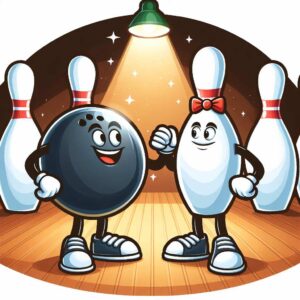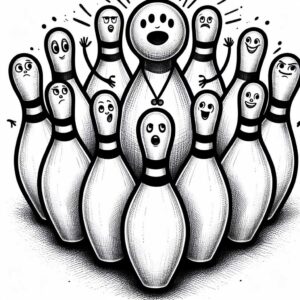If you’re serious about improving your bowling game, selecting the right ball size and weight is crucial. Many bowlers overlook this simple but vital aspect, leading to inconsistent performance and potential injuries. The size and weight of your bowling ball directly impact your rev rate, power, and overall scoring potential.
While bowling ball size is governed by strict regulations, the weight can vary significantly based on your skill level, physique, age, and bowling style. In this comprehensive guide, we’ll dive deep into the nuances of choosing an optimal bowling ball size and weight to help you take your game to new heights.
Bowling Ball Size Regulations:
Before we tackle weight considerations, it’s essential to understand the standard regulations surrounding bowling ball size. According to the United States Bowling Congress (USBC) and other governing bodies, a legal bowling ball must have a circumference between 26.7 and 27 inches.
This size range accommodates most adult bowlers comfortably. However, exceptions may apply for younger bowlers or individuals with exceptionally small or large hand sizes. In such cases, it’s advisable to consult with a professional at your local pro shop to find a ball that fits your hand properly while adhering to the regulations.
Factors Affecting Bowling Ball Weight:
While size is limited by rules, choosing the right bowling ball weight is a more nuanced decision influenced by several key factors:
Skill Level:
Generally, more experienced and skilled bowlers can handle heavier balls, as they possess the technique and strength to generate higher rev rates. Conversely, beginners and casual bowlers should start with lighter balls to develop proper form and avoid excessive strain.
Physique:
Your height, muscle mass, and overall body composition play a significant role in determining the ideal ball weight. Taller and more muscular individuals can typically manage heavier balls, while shorter or leaner bowlers may benefit from lighter weights.
Age and Gender:
Age and gender also influence ball weight considerations. Youth bowlers, for instance, should use lighter balls (typically 10-14 lbs) to prevent injuries during their growth and development stages. Similarly, many female bowlers prefer lighter weights, with a maximum recommendation of around 14 lbs, due to physiological differences.
Bowling Style:
Your bowling style, particularly your rev rate and ball speed, can dictate the optimal ball weight. Generally, bowlers with higher rev rates and faster ball speeds tend to perform better with lighter balls, as the increased revolutions and speed generate sufficient power. Conversely, straighter styles with lower rev rates often require heavier balls to create more driving force and pin action.
How to Choose the Right Weight:
With the various factors in mind, here are some general guidelines for selecting an appropriate bowling ball weight:
- Adult Men: Most adult male bowlers can comfortably handle balls ranging from 14 to 16 lbs, with 16 lbs being the maximum recommended weight.
- Adult Women: For adult female bowlers, a weight range of 10 to 14 lbs is common, with 14 lbs generally being the heaviest advisable weight.
- Youth Bowlers: Young bowlers (under 18) should start with lighter balls, typically between 6 and 10 lbs, and gradually increase weight as their skills and strength develop.
It’s important to note that these are merely guidelines, and individual preferences and abilities may vary. The best approach is to start with a lighter ball and gradually increase the weight as your skills improve and your body adapts. During practice sessions, try experimenting with different weights to assess your reaction, rev rate, and overall comfort level.
Benefits of Proper Ball Weight:
Choosing the right bowling ball weight offers numerous benefits that can significantly enhance your performance and overall bowling experience:
Increased Rev Rate and Power:
When you’re not over/under bowling (using a ball that’s too heavy or too light), you’ll be able to generate optimal rev rates and lane-carrying power, resulting in more strikes and higher scores.
Reduced Strain and Injury Risk:
Bowling with a ball that’s too heavy can put excessive strain on your arms, wrists, back, and other muscles, increasing the risk of injury. Using a properly weighted ball minimizes this strain, allowing you to bowl longer and more consistently without discomfort or risk of injury.
Better Overall Form and Consistency:
With the right ball weight, you’ll be able to maintain proper form throughout your approach and release, leading to greater consistency and repeatability in your shots.
Adjusting During a Series:
Even after finding your ideal ball weight, there may be situations where you need to make adjustments during a bowling series. For instance, as fatigue sets in or lane conditions change, you might consider going up or down in weight to compensate.
If you find yourself struggling to maintain rev rate or power towards the end of a series, switching to a slightly lighter ball can provide a boost and help you finish strong. Conversely, if the lanes are particularly dry or you’re leaving too many flat tens or solid 9-pins, a heavier ball could generate more driving force and improve your carry.
When transitioning between different weighted balls, it’s essential to take a few practice swings and shots to adjust your timing and feel. Abrupt weight changes can disrupt your release and overall consistency, so make transitions gradually and mindfully.
Care and Maintenance Tips:
Proper care and maintenance of your bowling balls are crucial to ensuring they maintain their intended weights and performance characteristics over time. Here are a few tips to keep in mind:
Regular Cleaning:
Dirt, oil, and other substances can accumulate on your bowling ball’s surface, altering its weight and reaction on the lanes. Regularly clean your balls using a certified ball cleaner and rejuvenator to maintain their factory-finish weight and performance.
Re-Drilling and Rebalancing:
As you use your bowling balls, the grips and holes can loosen over time, causing the balls to become unbalanced and potentially affecting their weight distribution. Periodically get your balls re-drilled and rebalanced by a professional to restore their original weight specifications.
Proper Storage:
Store your bowling balls in a cool, dry place, away from direct sunlight or extreme temperatures. Exposure to heat or moisture can cause the materials to expand or contract, altering the ball’s weight and overall performance.
Summary:
Finding the ideal bowling ball size and weight is a crucial aspect of optimizing your game and achieving consistent, high-level performance. By considering factors like skill level, physique, age, gender, and bowling style, you can select a ball that maximizes your rev rate, power, and scoring potential while minimizing the risk of injury.
Remember, the journey to finding your perfect ball weight may involve some experimentation and adjustment. Don’t be afraid to try different weights during practice sessions and consult with professionals at your local pro shop for personalized advice and guidance.
Continually assess and reevaluate your ball weight as your skills and body change over time. With the right ball in hand, you’ll be well-equipped to take your bowling game to new heights and enjoy the sport for years to come.





